Ottoman–Wallachian wars
Ottoman–Wallachian wars

The Battle of Varna took place on 10 November 1444 near Varna in what is today eastern Bulgaria. The Ottoman army under Sultan Murad II defeated the Crusaders commanded by King Władysław III of Poland and Hungary, John Hunyadi and Mircea II of Wallachia. It was the final battle of the unsuccessful Crusade of Varna, a last-ditch effort to prevent further Ottoman expansion into the Balkans.

Vlad II, also known as Vlad Dracul or Vlad the Dragon, was Voivode of Wallachia from 1436 to 1442, and again from 1443 to 1447. He is internationally known as the father of Vlad the Impaler, or Dracula. Born an illegitimate son of Mircea I of Wallachia, he spent his youth at the court of Sigismund of Luxembourg, who made him a member of the Order of the Dragon in 1431. Sigismund also recognized him as the lawful Voivode of Wallachia, allowing him to settle in nearby Transylvania. Vlad could not assert his claim during the life of his half-brother, Alexander I Aldea, who acknowledged the suzerainty of the Ottoman Sultan, Murad II.

The Second Battle of Kosovo was a land battle between a Hungarian-led Crusader army and the Ottoman Empire at Kosovo field that took place from 17–20 October 1448. It was the culmination of a Hungarian offensive to avenge the defeat at Varna four years earlier. In the three-day battle the Ottoman army under the command of Sultan Murad II defeated the Crusader army of regent John Hunyadi.

A series of military conflicts between the Ottoman Empire and various European states took place from the Late Middle Ages up through the early 20th century. The earliest conflicts began during the Byzantine–Ottoman wars, waged in Anatolia in the late 13th century before entering Europe in the mid-14th century with the Bulgarian–Ottoman wars. The mid-15th century saw the Serbian–Ottoman wars and the Albanian-Ottoman wars. Much of this period was characterized by the Ottoman expansion into the Balkans. The Ottoman Empire made further inroads into Central Europe in the 15th and 16th centuries, culminating in the peak of Ottoman territorial claims in Europe.
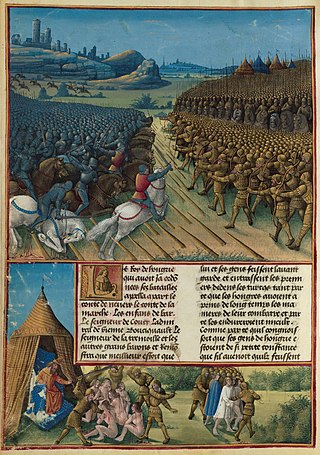
The Battle of Nicopolis took place on 25 September 1396 and resulted in the rout of an allied Crusader army at the hands of an Ottoman force, raising the siege of the Danubian fortress of Nicopolis and leading to the end of the Second Bulgarian Empire. It is often referred to as the Crusade of Nicopolis as it was one of the last large-scale Crusades of the Middle Ages, together with the Crusade of Varna in 1443–1444. By their victory at Nicopolis, the Turks discouraged the formation of future European coalitions against them. They maintained their pressure on Constantinople, tightened their control over the Balkans, and became a greater threat to Central Europe.
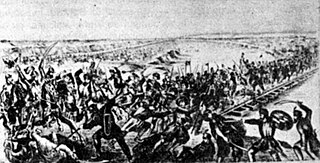
The Battle of Rovine took place on 17 May 1395. The Wallachian army led by Voivod Mircea the Elder opposed the Ottoman invasion personally led by Sultan Bayezid I the Thunderbolt. The Turkish force heavily outnumbered the Wallachian troops. The legend says that on the eve of the battle, dressed as a peace emissary, Mircea cel Bătrân talked to Bayezid asking him to leave Wallachia and promised him safe passage back. The Sultan proudly insisted on fighting later suffering a humiliating loss.

The Battle of Călugăreni took place during the history of early modern Romania on 23 August [O.S. 13 August] 1595 between the Wallachian army led by Michael the Brave and the Ottoman army led by Koca Sinan Pasha. It was part of the Long Turkish War, fought between Christian and Ottoman forces at the end of the 16th – beginning of the 17th centuries.

The Battle of Vaslui was fought on 10 January 1475, between Stephen III of Moldavia and the Ottoman governor of Rumelia, Hadım Suleiman Pasha. The battle took place at Podul Înalt, near the town of Vaslui, in Moldavia. The Ottoman troops numbered up to 30,000 or 120,000, facing about 40,000 Moldavian troops, plus smaller numbers of allied and mercenary troops.

The night attack at Târgoviște was a battle fought between forces of Prince Vlad III of Wallachia, and Sultan Mehmed II of the Ottoman Empire on Thursday, 17 June 1462. The battle started after Mehmed II, who already had tense relations with Vlad, discovered his alliance with Hungary's king Matthias Corvinus and ordered his forces to ambush him. Vlad foiled the attack and invaded Bulgaria. In response, Mehmed raised a great army with the objective to conquer Wallachia. The two leaders fought a series of skirmishes, the most notable one being the conflict where Vlad attacked the Turkish camp in the night in an attempt to kill Mehmed. The assassination attempt failed and Mehmed marched to the Wallachian capital of Târgoviște, where he found a few men with cannons. After leaving the capital, Mehmed discovered 23,844 impaled Turks whom Vlad had killed during his invasion of Bulgaria. The number is mentioned by Vlad himself in a letter to Matthias Corvinus. The sultan and his troops then sailed to Brăila and burned it to the ground before retreating to Adrianople. Mehmed's forces returned home with many captured slaves, horses, and cattle.
The Battle of Karanovasa took place on 10 October 1394 between the Wallachian army led by Voivode Mircea cel Bătrân against an Ottoman invasion led by Sultan Bayezid I. This battle is sometimes confused with the later Battle of Rovine between the same combatants, and which took place also along the valley of the Argeș River.
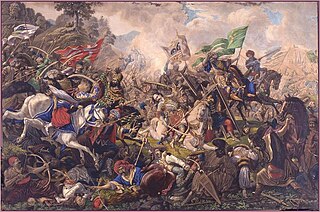
The Battle of Breadfield was the most tremendous conflict fought in Transylvania up to that time in the Ottoman–Hungarian Wars, taking place on October 13, 1479, on the Breadfield near the Saxon village of Alkenyér next to the river Maros (Mureș). The Hungarian army was led by Pál Kinizsi, István Báthory, Vuk Branković, and Basarab Laiotă cel Bătrân.

The Crusade of Varna was an unsuccessful military campaign mounted by several European leaders to check the expansion of the Ottoman Empire into Central Europe, specifically the Balkans between 1443 and 1444. It was called by Pope Eugene IV on 1 January 1443 and led by King Władysław III of Poland, John Hunyadi, Voivode of Transylvania, and Duke Philip the Good of Burgundy.
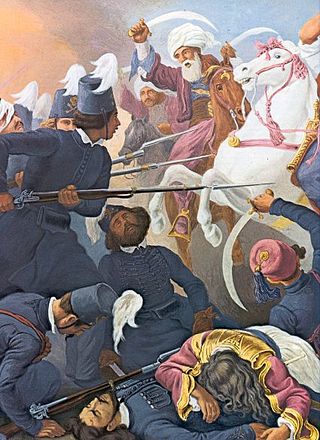
The Battle of Drăgășani was fought on 19 June 1821 in Drăgășani, Wallachia, between the Ottoman forces of Sultan Mahmud II and the Greek Filiki Etaireia insurgents as a part of the Greek War of Independence.
The Ottoman–Venetian wars were a series of conflicts between the Ottoman Empire and the Republic of Venice that started in 1396 and lasted until 1718. It included:

The Hungarian–Ottoman wars were a series of battles between the Ottoman Empire and the medieval Kingdom of Hungary. Following the Byzantine Civil War, the Ottoman capture of Gallipoli, and the decisive Battle of Kosovo, the Ottoman Empire was poised to conquer the entirety of the Balkans. It also sought and expressed desire to expand further north into Central Europe, beginning with the Hungarian lands.

The military history of Romania deals with conflicts spreading over a period of about 2500 years across the territory of modern Romania, the Balkan Peninsula and Eastern Europe and the role of the Romanian military in conflicts and peacekeeping worldwide.
Sırpsındığı was according to Ottoman sources, a sudden night raid by an Ottoman force led by Hacı İlbey on a Serbian contingent at the banks of the Maritsa river about 15 kilometres from the city of Adrianople. It occurred in 1364 between an expeditionary force of the Ottomans and a Serbian army that also included crusaders, led by king Louis I of Hungary, sent by the Pope. The Ottomans destroyed the Serbian army, which is why the battle was known as "sırp sındığı". The battle was the first attempt to throw the Ottomans from the Balkans with an allied army. There is no record of this battle in any Serbian, Hungarian, papal, or other European sources.

Battle of Girurgiu 1462
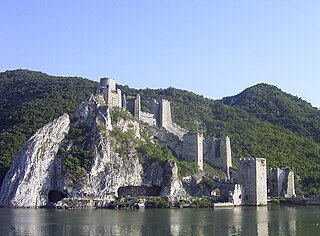
The siege of Golubac was a military conflict between the Hungarian–Wallachian–Lithuanian alliance and the Ottoman Empire in May 1428. This siege was the first battle in Hungarian military history in which the Hungarian army used significant artillery. However, they could not capture Golubac and were defeated by the Ottoman main army, led by Sultan Murad II. After the battle, most of Serbia and Bosnia was conquered by the Ottoman Army.
The medieval fortress of Turnu is located in the southern part of Turnu Măgurele at a distance of 3 km from the city and 1 km from the confluence of the Olt and Danube rivers in today's Romania. The fortress is documented during the reign of Mircea the Elder (1394) and was built on the Danube line for the defense of Wallachia against the Turkish peril. At the end of the reign of Mircea the Elder, under unclear circumstances, it came under Ottoman occupation to return to the possession of Wallachia only in 1829 when it was burned and demolished.